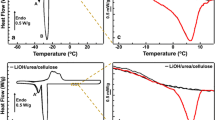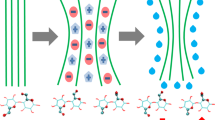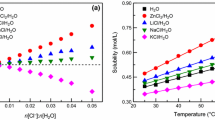Abstract
Anions are always considered to explain most of the cellulose dissolution in the ionic liquid; where electron donor theory is always used to elaborate cellulose dissolution in the ionic liquids with different anions. However, the theory does not apply to ionic liquids with different alkyl chain anions. Herein, the hydrogen bond theory was proposed to further explain cellulose dissolution by density functional theory (DFT) calculations. 1-allyl-3-methylimidazole carboxylate ionic liquids with different alkyl chains including ([Amim][HCOO], [Amim][CH3COO], [Amim][CH3CH2COO], [Amim][CH3CH2CH2COO]) were investigated. The DFT results indicated that the alkyl chains of the anions directly affect the hydrogen bond and the interaction energy between the cations and anions; where the length of the hydrogen bonds between cation and anion is the most predominant factor for determining the polarity parameter β value of the ionic liquid itself and therefore governing cellulose dissolution. Moreover, a shorter length of hydrogen bonds between the anions of ionic liquid and cellobiose referred to a better solubility of cellulose in the ionic liquids.
Graphical abstract










Similar content being viewed by others
Notes
Note: The β value and cellulose solubility are the averages at 25–80 °C. Xu and Wang (2020) Carboxylate ionic liquid solvent systems from 2006 to 2020: thermal properties and application in cellulose processing. Green Chemistry 22(22):7622–7664.
References
Basiuk VA, Henao-Holguín LV (2013) Effects of orbital cutoff in DMol3 DFT calculations: a case study of meso-tetraphenylporphine-C60 complex. J Comput Theor Nanosci 10:1266–1272. https://doi.org/10.1166/jctn.2013.284
Cao B, Du J, Du D, Sun H, Zhu X, Fu H (2016) Cellobiose as a model system to reveal cellulose dissolution mechanism in acetate-based ionic liquids: density functional theory study substantiated by NMR spectra. Carbohydr Polym 149:348–356. https://doi.org/10.1016/j.carbpol.2016.04.128
Cocinero EJ, Gamblin DP, Davis BG, Simons JP (2009) The building blocks of cellulose: the intrinsic conformational structures of cellobiose, its epimer, lactose, and their singly hydrated complexes. J Am Chem Soc 131:11117–11123. https://doi.org/10.1021/ja903322w
Delley B (1998) Scattering theoretic approach to scalar relativistic corrections on bonding. Quantum Chem 69:423–433. https://doi.org/10.1002/(SICI)1097-461X(1998)69:3%3c423::AID-QUA19%3e3.0.CO;2-2
Delley B (2000) From molecules to solids with the DMol3 approach. J Chem Phys 113:7756–7764. https://doi.org/10.1063/1.1316015
Dokoohaki MH, Zolghadr AR, Ghatee MH, Klein A (2020) Aqueous solutions of binary ionic liquids: insight into structure, dynamics, and interface properties by molecular dynamics simulations and DFT methods. Phys Chem Chem Phys 22:27882–27895. https://doi.org/10.1039/D0CP04303F
Dong K, Zhang S, Wang J (2016) Understanding the hydrogen bonds in ionic liquids and their roles in properties and reactions. Chem Commun (camb) 52:6744–6764. https://doi.org/10.1039/c5cc10120d
Erdmenger T, Haensch C, Hoogenboom R, Schubert US (2007) Homogeneous tritylation of cellulose in 1-butyl-3-methylimidazolium chloride. Macromol Biosci 7:440–445. https://doi.org/10.1002/mabi.200600253
Festucci-Buselli RA, Otoni WC, Joshi CP (2007) Structure, organization, and functions of cellulose synthase complexes in higher plants. Braz J Plant Physiol 19:1–13. https://doi.org/10.1590/s1677-04202007000100001
French AD, Johnson GP, Cramer CJ, Csonka GI (2012) Conformational analysis of cellobiose by electronic structure theories. Carbohydr Res 350:68–76. https://doi.org/10.1016/j.carres.2011.12.023
Gao Y, Zhang LQ, Wang Y, Li HR (2010) Probing electron density of H-bonding between cation-anion of imidazolium-based ionic liquids with different anions by vibrational spectroscopy. J Phys Chem B 114:2828–2833. https://doi.org/10.1021/jp910528m
Guo J, Zhang D, Duan C, Liu C (2010) Probing anion-cellulose interactions in imidazolium-based room temperature ionic liquids: a density functional study. Carbohydr Res 345:2201–2205. https://doi.org/10.1016/j.carres.2010.07.036
Hauru LK, Hummel M, King AW, Kilpelainen I, Sixta H (2012) Role of solvent parameters in the regeneration of cellulose from ionic liquid solutions. Biomacromol 13:2896–2905. https://doi.org/10.1021/bm300912y
He Y, Guo Y, Yan F, Yu T, Liu L, Zhang X, Zheng T (2021) Density functional theory study of adsorption of ionic liquids on graphene oxide surface. Chem Eng Sci. https://doi.org/10.1016/j.ces.2021.116946
Hirshfeld FL (1977) Bonded-atom fragments for describing molecular charge densities. Theoret Chim Acta 44:129–138. https://doi.org/10.1007/BF00549096
Hu K, Kong M, Qin M, Zeng J, Ai B, Zhang J (2021) Experimental and theoretical studies of chitosan dissolution in ionic liquids: contribution ratio effect of cations and anions. J Mol Liq. https://doi.org/10.1016/j.molliq.2021.115762
Kamlet MJ, Abboud JL, Abraham MH, Taft RW (1983) Linear solvation energy relationships. 23. A comprehensive collection of the solvatochromic parameters, *, a, and ß, and some methods forsimplifying the generalized solvatochromic equation. J Org Chem 48:2877–2887. https://doi.org/10.1021/jo00165a018
Kumar K, Khatri V, Upadhyayula S, Kashyap HK (2021) Cellulose conversion to biofuel precursors using conjugated ionic liquid catalyst: an experimental and DFT study†. Appl Catal A Gen. https://doi.org/10.1016/j.apcata.2020.117951
Li Y, Wang J, Liu X, Zhang S (2018) Towards a molecular understanding of cellulose dissolution in ionic liquids: anion/cation effect, synergistic mechanism and physicochemical aspects. Chem Sci 9:4027–4043. https://doi.org/10.1039/C7SC05392D
Lu B, Xu A, Wang J (2014a) Cation does matter: how cationic structure affects the dissolution of cellulose in ionic liquids. Green Chem 16:1326–1335. https://doi.org/10.1039/C3GC41733F
Lu B, Xu A, Wang J (2014) Cation does matter: how cationic structure affects the dissolution of cellulose in ionic liquids. Green Chem 16:1326–1335. https://doi.org/10.1039/C3GC41733F
Mostaani E, Drummond ND, Fal’ko VI (2015) Quantum Monte Carlo calculation of the binding energy of bilayer graphene. Phys Rev Lett 115:115501. https://doi.org/10.1103/PhysRevLett.115.115501
Nishiyama Y, Johnson GP, French AD, Forsyth VT, Langan P (2008) Neutron crystallography, molecular dynamics, and quantum mechanics studies of the nature of hydrogen bonding in cellulose Iβ. Biomacromol 9:3133–3140. https://doi.org/10.1021/bm800726v
Novoselov N, Sashina E, Petrenko V, Zaborsky M (2007) Study of dissolution of cellulose in ionic liquids by computer modeling. Fibre Chem 39:153–158. https://doi.org/10.1007/s10692-007-0030-y
Patel DD, Lee JM (2012) Applications of ionic liquids. Chem Rev 12:329–355. https://doi.org/10.1002/tcr.201100036
Payal RS, Bharath R, Periyasamy G, Balasubramanian S (2012) Density functional theory investigations on the structure and dissolution mechanisms for cellobiose and xylan in an ionic liquid: gas phase and cluster calculations. J Phys Chem C 116:833–840. https://doi.org/10.1021/jp207989w
Payal RS, Bejagam KK, Mondal A, Balasubramanian S (2015) Dissolution of cellulose in room temperature ionic liquids: anion dependence. J Phys Chem B 119:1654–1659. https://doi.org/10.1021/jp512240t
Perdew JP, Burke K, Ernzerhof M (1996) Generalized gradient approximation made simple. Phys Rev Lett 77:3865–3868. https://doi.org/10.1103/PhysRevLett.77.3865
Plechkova NV, Seddon KR (2008) Applications of ionic liquids in the chemical industry. Chem Soc Rev 37:123–150. https://doi.org/10.1039/B006677J
Politzer P, Laurence PR, Jayasuriya K (1985) Molecular electrostatic potentials: an effective tool for the elucidation of biochemical phenomena. Environ Health Persp 61:191–202. https://doi.org/10.1289/ehp.8561191
Politzer P, Lane P, Concha MC, Ma Y, Murray JS (2007) An overview of halogen bonding. J Mol Model 13:305–311. https://doi.org/10.1007/s00894-006-0154-7
Remsing RC, Swatloski RP, Rogers RD, Moyna G (2006) Mechanism of cellulose dissolution in the ionic liquid 1-n-butyl-3-methylimidazolium chloride: a 13C and 35/37Cl NMR relaxation study on model systems. Chem Commun (camb) 12:1271–1273. https://doi.org/10.1039/b600586c
Sheldon RA, Lau RM, Sorgedrager MJ, Rantwijk FV, Seddon KR (2002) Biocatalysis in ionic liquids. Green Chem 4:147–151. https://doi.org/10.1039/B110008B
Shukla M, Srivastava N, Saha S (2010) Theoretical and spectroscopic studies of 1-butyl-3-methylimidazolium iodide room temperature ionic liquid: its differences with chloride and bromide derivatives. J Mol Struct 975:349–356
Sjoberg P, Politzer P (1990) Use of the electrostatic potential at the molecular surface to interpret and predict nucleophilic processes. J Phys Chem C 94:3959–3961. https://doi.org/10.1021/j100373a017
Stark A, Sellin M, Ondruschka B, Massonne K (2012) The effect of hydrogen bond acceptor properties of ionic liquids on their cellulose solubility. Sci China: Chem 55:1663–1670. https://doi.org/10.1007/s11426-012-4685-8
Swatloski RP, Spear SK, Holbrey JD, Rogers RD (2002) Dissolution of cellose with ionic liquids. J Am Chem Soc 124:4974–4975. https://doi.org/10.1021/ja025790m
Tomimatsu Y, Suetsugu H, Yoshimura Y, Shimizu A (2019) The solubility of cellulose in binary mixtures of ionic liquids and dimethyl sulfoxide: influence of the anion. J Mol Liq 279:120–126. https://doi.org/10.1016/j.molliq.2019.01.093
Xu A, Wan F (2020) Carboxylate ionic liquid solvent systems from 2006 to 2020: thermal properties and application in cellulose processing. Green Chem 22:7622–7664. https://doi.org/10.1039/D0GC02840A
Xu A, Wang J, Wang H (2010) Effects of anionic structure and lithium salts addition on the dissolution of cellulose in 1-butyl-3-methylimidazolium-based ionic liquid solvent systems. Green Chem 12:268–275. https://doi.org/10.1039/b916882f
Xu A, Wang J, ZhangY CQ (2012a) Effect of alkyl chain length in anions on thermodynamic and surface properties of 1-butyl-3-methylimidazolium carboxylate ionic liquids. Ind Eng Chem Res 51:3458–3465. https://doi.org/10.1021/ie201345t
Xu H, Pan W, Wang R, Zhang D, Liu C (2012b) Understanding the mechanism of cellulose dissolution in 1-butyl-3-methylimidazolium chloride ionic liquid via quantum chemistry calculations and molecular dynamics simulations. J Comput Aid Mol Des 26:329–337. https://doi.org/10.1007/s10822-012-9559-9
Xu A, Zhang Y, Lu W, Yao K, Xu H (2014) Effect of alkyl chain length in anion on dissolution of cellulose in 1-butyl-3-methylimidazolium carboxylate ionic liquids. J Mol Liq 197:211–214. https://doi.org/10.1016/j.molliq.2014.05.018
Xu A, Chen L, Wang J (2018) Functionalized imidazalium carboxylates for enhancing practical applicability in cellulose processing. Macromolecules 51:4158–4166. https://doi.org/10.1021/acs.macromol.8b00724
Yin Z, Pan Z, Wang C, Dong Y, Ou Y (2007) Composition, structure and mechanical properties of several natural cellular materials. Chin Sci Bull 52:2903–2908. https://doi.org/10.1007/s11434-007-0432-5
Zhang JM, Zhang H, Wu J, Zhang J, He J et al (2010) NMR spectroscopic studies of cellobiose solvation in EmimAc aimed to understand the dissolution mechanism of cellulose in ionic liquids. Phys Chem Chem Phys 12:1941–1947. https://doi.org/10.1039/B920446F
Zhang Y, Xu A, Lu B, Li Z, Wang J (2015) Dissolution of cellulose in 1-allyl-3-methylimizodalium carboxylates at room temperature: a structure-property relationship study. Carbohydr Polym 117:666–672. https://doi.org/10.1016/j.carbpol.2014.08.101
Zhang JM, Xu LL, Yu J, Wu J (2016) Understanding cellulose dissolution: effect of the cation and anion structure of ionic liquids on the solubility of cellulose. Sci China Chem 59:1421–1429. https://doi.org/10.1007/s11426-016-0269-5
Zhao Y, Liu X, Wang J, Zhang S (2013) Effects of anionic structure on the dissolution of cellulose in ionic liquids revealed by molecular simulation. Carbohydr Polym 94:723–730. https://doi.org/10.1016/j.carbpol.2013.02.011
Acknowledgments
The authors would like to acknowledge gratefully for the financial support from the Industry-University Project of Fujian Provincial Department of Science and Technology (2021H6008 and 2021H6005) and National Supercomputing Center in Shenzhen for this intensive research program.
Funding
Industry-University Project of Fujian Provincial Department of Science and Technology, 2021H6008, Shilin Cao, Industry-University Project of Fujian Provincial Department of Science and Technology, 2021H6005, Xiaojuan Ma.
Author information
Authors and Affiliations
Contributions
All authors contributed to the study conception and design. Material preparation, data collection and analysis were performed by XL, SX, JC, LN, XM, SC and HG. The first draft of the manuscript was written by Xingmei Lu and all authors commented on previous versions of the manuscript. All authors read and approved the final manuscript.
Corresponding authors
Ethics declarations
Conflict of interest
The authors declare that they have no known competing financial interests or personal relationships that could have appeared to influence the work reported in this paper.
Additional information
Publisher's Note
Springer Nature remains neutral with regard to jurisdictional claims in published maps and institutional affiliations.
Supplementary Information
Below is the link to the electronic supplementary material.
Rights and permissions
Springer Nature or its licensor (e.g. a society or other partner) holds exclusive rights to this article under a publishing agreement with the author(s) or other rightsholder(s); author self-archiving of the accepted manuscript version of this article is solely governed by the terms of such publishing agreement and applicable law.
About this article
Cite this article
Lu, X., Xu, S., Chen, J. et al. Cellulose dissolution in ionic liquid from hydrogen bonding perspective: first-principles calculations. Cellulose 30, 4181–4195 (2023). https://doi.org/10.1007/s10570-023-05140-9
Received:
Accepted:
Published:
Issue Date:
DOI: https://doi.org/10.1007/s10570-023-05140-9




